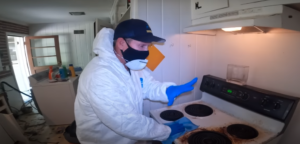
Rats in the attic are a big cause of concern. In addition to the wide array of health problems they carry, they can cause a lot of damage to your house.
And who can sleep when there is constant squeaking and scurrying in the attic?
It’s downright irritating.
The best way is to keep rats away from entering your house in the first place. For that purpose, you must know how they are infiltrating your house. Once you determine that, you can seal off the entry points, then you can work on getting rid of them.
Common Ways Rats Get Into Your House or Attic
Rats can enter your house through openings you may not even suspect. They can squeeze their bodies through holes as small as a quarter-inch in diameter. They can also chew through plastic, wood, drywall, and aluminum sidings. These rodents generally prefer to stay above the ground that is why more often than not they are found in the roof. So, if you’ve noticed any sign of roof rats, you must follow these ways to check and cover all their entry points.
Wall Cracks
Most times these rodents enter your house through cracks in the walls. So, check the exteriors of your house for any cracks or potential entry points. Use a waterproof sealant to permanently cover these entry points.
Window Gaps
Some house windows have crevices or small openings on the side. The rats in your roof may have entered your house through them. Check all the windows of your house and see if there are any nickel-sized holes. If you find any, seal them instantly.
Chimney
Chimneys are one of the easiest roofs for rats to enter your house as they look for warmth and food. In case you have a chimney in your house, it is best you hire professionals and get it cleaned. To prevent any infestation of rats in your house through the chimney again, you can get a grate or chimney gap installed.
Vents
Vents generally have large enough holes for these rodents to squeeze through. They can even fit through gaps around the vents. That is why you must look for any such openings in and around vents and get them sealed.
Roof Holes
If you have rats in your attic, then one of the most probable entry points is the roof. That is why it is for the best that you hire professionals to check your roof for any rodent entry points. These little miscreants can chew off cap plugs and can enter your attic through them. Make sure you get them sealed with a waterproof sealant.
Essentially, if you suspect your attic is hosting rats, then you must be on a vigilant lookout for weak areas in your house that you feel can be chewed off by rats. They can actually chew through a lot of materials including plastic, wood, pipes, etc.
If the house in your attic for a long time then not only is that a huge health concern for you and your family but can result in serious damages to the structure of your building. They can be a huge menace as they may bite electrical cables which can create a fire hazard.
That is why finding out that you have a rodent problem and then sealing off any entry points won’t cut it. You have to get rid of the rats that are already present in your house. Here is how you can solve this problem:
Improve Sanitation
This is probably the best way to keep rats away from your property and put an end to any existingrat infestation. Rats need water, food, and warmth for survival that is why they live in places where they can find this easily. So, to reduce rats infesting your attic:
- Keep food in tight containers instead of any cardboard boxes or materials that they can chew through.
- Get rid of any paper or cardboard clutter from your attic. Rats often use these to make their nests. Do not give them raw material to build their houses in your house.
- Most homeowners keep their pet food out in the open which can attract a lot of rats. So, keep pet food in storage containers. Also, do not let any pet food sit out in the open overnight.
- Keep the outsides of your house clean. Rats thrive in unhygienic and dirty conditions. So, clean weeds and any other wild vegetation from around the house.
Seal Entry Points
As discussed earlier, it is important to understand where the rats are entering your house from. So, look for any holes inside your house and then seal those points.
Here is how you can accomplish that:
- Seal any potential entry point that is as small as a half-inch hole. You may use materials such as mesh, caulk, and wood to seal them off.
- For any holes around pipes, you may use Xcluder or copper mesh cloth.
- Get flood drains checked for any openings.
- Most times, rats look for spaces underneath doors and on the sides of the windows. That is why you must make sure that all these work and fit perfectly.
Bait & Trap
Most times, the simplest of solutions is exactly what you require. This method effectively works in a way that the rat is baited with something they like but in reality, is poisonous or a trap. As professionals, we recommend you to bait effectively. That is why we suggest not using such baits indoors.
In other words, if the rat consumes the poison inside, it will make it all the more difficult to remove the carcass. On the other hand, you may choose to use a trapping method indoors. Basically in this method, you do not require rodenticides.
Final Words
In a nutshell, having rats in your attics can be a huge downside. They can cause several health and damage concerns. Precisely why we wrote this guide to help you first find out the ways rats have infested your building and afterward understand how to get rid of these rodents. Keep in mind these aforementioned tips for solving rat infestation.
Tell us your rodent experiences in the comment section below.





